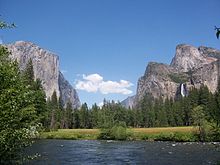- Ecology of California
-
This article describes natural biological communities. See Environment of California for a description of human habitat adjustments.
The ecology of California is diverse: it is considered to span six biogeographic provinces or ecoregions:[1] "Coastal Chaparral Forest and Shrub", "Dry Steppe", "Coastal Steppe, Mixed Forest, and Redwood Forest", "Sierran Steppe/Mixed Forest/Coniferous Forest", "Coastal Range Open Woodland/Shrub/ Coniferous Forest/Meadow", and "American Semi-Desert and Desert".
Botanists generally consider the California chaparral and woodlands, Sierra Nevada forests, Central Valley grasslands, Northern California coastal forests, and Klamath-Siskiyou as a single California Floristic Province, which does not include the deserts of eastern California, which belong to other floristic provinces. Many Bioregionalists, including poet Gary Snyder, identify the central and northern Coast Ranges, Klamath-Siskiyou, the Central Valley, and Sierra Nevada as Alta California or the Shasta Bioregion.
Contents
The ecoregions
Semi-desert and desert
California's high mountains block most moisture from reaching the eastern parts of the state, which are home to California's desert and xeric shrub ecoregions. The low desert of southeastern California is part of the Sonoran desert ecoregion, which extends into Arizona and parts of northern Mexico. Southern California's high deserts constitute the Mojave desert ecoregion, which has affinities to the Great Basin shrub steppe, which covers California's Owens Valley and Modoc Plateau, as well as most of neighboring Nevada.
Coastal chaparral
The southern and central Coast Ranges, including the San Francisco Bay Area and Los Angeles region, comprise California's Mediterranean Forests, Woodlands, and Scrub ecoregions. These contain numerous plant communities, including oak savanna, oak woodland, conifer woodlands, chaparral, coastal sage scrub, and coastal grassland; these plant communities often occur as a mosaic, with patches of distinct plant communities situated in response to site conditions, including variations in sun exposure (north or south slopes), wind exposure, and soils, and variations in rainfall between wetter seaward slopes and the drier rain shadow on the landward slopes.
In the south, the California coastal sage and chaparral extends across the Mexican border into northwestern Baja California and Los Angeles. The California montane chaparral and woodlands include the Transverse Ranges north of Los Angeles as well as the Santa Lucia Range on the Central Coast. The California interior chaparral and woodlands form a ring around the Central Valley, covering the hills around the Bay Area as well as the foothills of the Sierra Nevada.
Dry steppe
California's Central Valley was once a large temperate grassland, the California Central Valley grasslands ecoregion, which was formerly home to great herds of grazing pronghorn and elk; some writers have referred to it as "America's Serengeti". The Central Valley has been mostly converted to farms and rangeland; its once great seasonal wetlands have been drained and its perennial bunch grasses replaced by exotic annual grasses[2] or farm fields, but patches of the native bunchgrasses still exist, as do some of the small seasonal wetlands known as vernal pools.
Temperate coniferous forests
The cooler and wetter mountains of northern California are covered by temperate coniferous forests. Along the eastern edge of California, the mountainous Sierra Nevada forests are home to the world's most massive tree, the Giant Sequoia (Sequoiadendron giganteum) and the contiguous United States' highest point, Mount Whitney. Wet-season rain and dry-season fog support the Northern California coastal forests, which grow the world's tallest tree, the Coast redwood (Sequoia sempervirens). Inland, the Klamath-Siskiyou forests support some of the world's most diverse coniferous forests. In sparsely-populated northeastern are the Eastern Cascades forests.
See also
- California Floristic Province
- California native plants
- Category: Endemic flora of California
- Geography of California
- Global warming in California
- List of California birds
- California Environmental Protection Agency
References
Environment of the United States by political division States - Alabama
- Alaska
- Arizona
- Arkansas
- California
- Colorado
- Connecticut
- Delaware
- Florida
- Georgia
- Hawaii
- Idaho
- Illinois
- Indiana
- Iowa
- Kansas
- Kentucky
- Louisiana
- Maine
- Maryland
- Massachusetts
- Michigan
- Minnesota
- Mississippi
- Missouri
- Montana
- Nebraska
- Nevada
- New Hampshire
- New Jersey
- New Mexico
- New York
- North Carolina
- North Dakota
- Ohio
- Oklahoma
- Oregon
- Pennsylvania
- Rhode Island
- South Carolina
- South Dakota
- Tennessee
- Texas
- Utah
- Vermont
- Virginia
- Washington
- West Virginia
- Wisconsin
- Wyoming
Federal district Insular areas- American Samoa
- Guam
- Northern Mariana Islands
- Puerto Rico
- U.S. Virgin Islands
Outlying islands - Bajo Nuevo Bank
- Baker Island
- Howland Island
- Jarvis Island
- Johnston Atoll
- Kingman Reef
- Midway Atoll
- Navassa Island
- Palmyra Atoll
- Serranilla Bank
- Wake Island
Categories:- Environment of California
- Natural history of California
- Plant communities of California
- Regions of California
Wikimedia Foundation. 2010.




